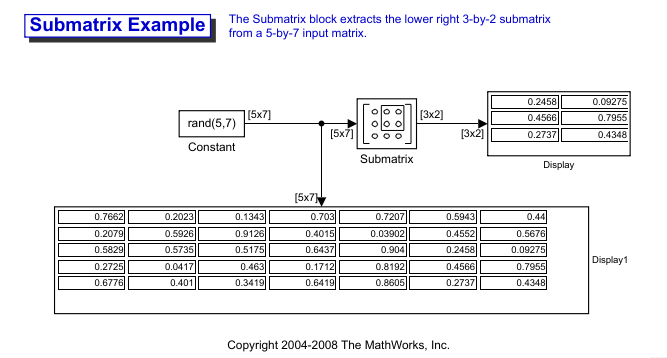Deconstruct Multichannel Signals for Sample-Based Processing
In sample-based processing, blocks process signals one sample at a time. Each element of the input signal represents one sample in a distinct channel. If the input signal is a matrix, each element corresponds to the same time. For example, from a sample-based processing perspective, this 3-by-2 matrix contains the first sample in each of the six independent channels.

When you configure a block to perform sample-based processing, the block interprets a scalar input as a single-channel signal. Similarly, the block interprets an M-by-N matrix as a multichannel signal with M*N independent channels. For example, in sample-based processing, blocks interpret this sequence of 3-by-2 matrices as a six-channel signal.

Split Multichannel Signals into Individual Signals
Multichannel signals, represented by matrices in the Simulink® environment, are frequently used in signal processing models for efficiency and compactness. Though most of the signal processing blocks can process multichannel signals, you may need to access just one channel or a particular range of samples in a multichannel signal. You can access individual channels of the multichannel signal by using the blocks in the Indexing library. This library includes the Selector, Submatrix, Variable Selector, Multiport Selector, and Submatrix blocks.
You can split a multichannel based signal into single-channel signals using the Multiport Selector block. This block allows you to select specific rows and/or columns and propagate the selection to a chosen output port. In this example, a three-channel signal of size 3-by-1 is deconstructed into three independent signals of sample period 1 second.
Open the ex_splitmltichsbsigsind model.

Double-click the Signal From Workspace block, and set the block parameters as follows:
Signal =
randn(3,1,10)Sample time = 1
Samples per frame = 1
Based on these parameters, the Signal From Workspace block outputs a three-channel signal with a sample period of 1 second.
Save these parameters and close the dialog box by clicking OK.
Double-click the Multiport Selector block. Set the block parameters as follows, and then click OK:
Select =
RowsIndices to output = {1,2,3}
Based on these parameters, the Multiport Selector block extracts the rows of the input. The Indices to output parameter setting specifies that row 1 of the input should be reproduced at output 1, row 2 of the input should be reproduced at output 2, and row 3 of the input should be reproduced at output 3.
Run the model.
At the MATLAB® command line, type dsp_examples_yout. Because the input signal is random, your output might be different than the output shown here. This signal is the first row of the input to the Multiport Selector block. You can view the other two input rows by typing dsp_examples_yout1 and dsp_examples_yout2, respectively.
dsp_examples_yout(:,:,1) =
0.8884
dsp_examples_yout(:,:,2) =
-0.8095
dsp_examples_yout(:,:,3) =
0.3252
dsp_examples_yout(:,:,4) =
-1.7115
dsp_examples_yout(:,:,5) =
0.3192
dsp_examples_yout(:,:,6) =
-0.0301
dsp_examples_yout(:,:,7) =
1.0933
dsp_examples_yout(:,:,8) =
0.0774
dsp_examples_yout(:,:,9) =
-0.0068
dsp_examples_yout(:,:,10) =
0.3714
dsp_examples_yout(:,:,11) =
0
You have now successfully created three single-channel signals from a multichannel signal using a Multiport Selector block.
Split Multichannel Signals into Several Multichannel Signals
Multichannel signals, represented by matrices in the Simulink environment, are frequently used in signal processing models for efficiency and compactness. Though most of the signal processing blocks can process multichannel signals, you may need to access just one channel or a particular range of samples in a multichannel signal. You can access individual channels of the multichannel signal by using the blocks in the Indexing library. This library includes the Selector, Submatrix, Variable Selector, Multiport Selector, and Submatrix blocks.
You can split a multichannel signal into other multichannel signals using the Submatrix block. The Submatrix block is the most versatile of the blocks in the Indexing library because it allows arbitrary channel selections. Therefore, you can extract a portion of a multichannel signal. In this example, you extract a six-channel signal from a 35-channel signal (a matrix of size 5-by-7). Each channel contains one sample.
Open the ex_splitmltichsbsigsev model.

Double-click the Constant block, and set the block parameters as follows:
Constant value = rand(5,7)
Clear the Interpret vector parameters as 1-D check box
Sample Time = 1
Based on these parameters, the Constant block outputs a constant-valued signal.
Save these parameters and close the dialog box by clicking OK.
Double-click the Submatrix block. Set the block parameters as follows, and then click OK:
Row span =
Range of rowsStarting row =
IndexStarting row index = 3
Ending row =
LastColumn span =
Range of columnsStarting column =
Offset from lastStarting column offset = 1
Ending column =
Last
Based on these parameters, the Submatrix block outputs rows three to five, the last row of the input signal. It also outputs the second to last column and the last column of the input signal.
Run the model. The model should now look similar to the following figure.

Notice that the output of the Submatrix block is equivalent to the matrix created by rows three through five and columns six through seven of the input matrix.
You have now successfully created a six-channel signal from a 35-channel signal using a Submatrix block. Each channel contains one sample.
See Also
Topics
- Sample- and Frame-Based Concepts
- Create Signals for Sample-Based Processing
- Create Signals for Frame-Based Processing
- Deconstruct Multichannel Signals for Frame-Based Processing
- Import and Export Signals for Sample-Based Processing
- Import and Export Signals for Frame-Based Processing
- Inspect Sample and Frame Rates in Simulink
- Convert Sample and Frame Rates in Simulink Using Rate Conversion Blocks